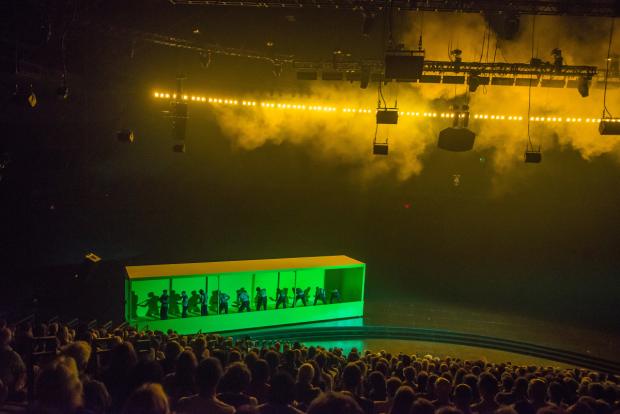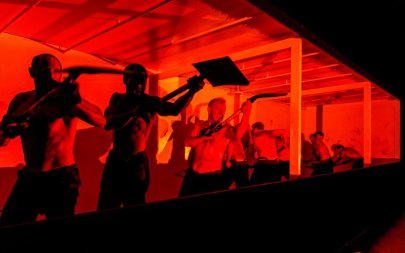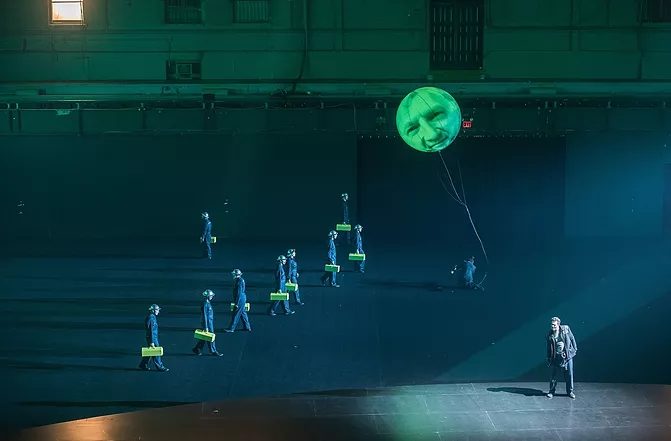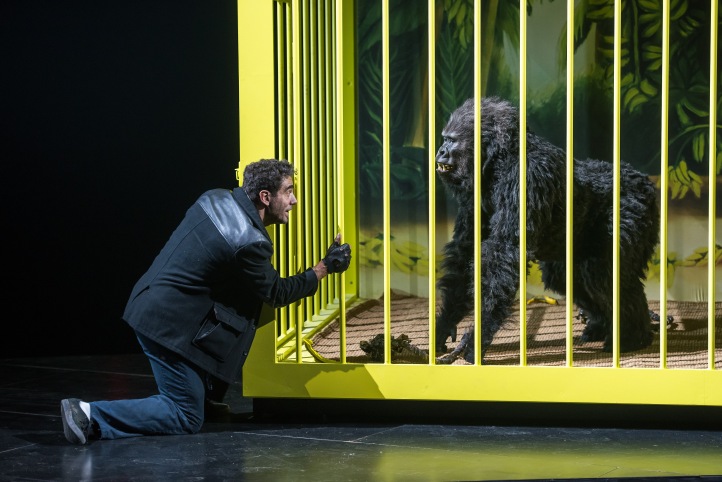
Eugene O’Neill’s The Hairy Ape: Spinning Out, Caged
By Ross
The streets that haunt the soul of the bewildered Yank are where this exceptional revival of Eugene O’Neill’s The Hairy Ape finds itself expressionally planted. Intensely staged most beautifully by director, Richard Jones (Broadway’s La Bête) and designer, Stewart Laing (Broadway’s Titanic) in the majestic and cavernous Park Avenue Armory, O’Neill has never felt so unique and powerful. The two work quite dramatically together creating something unlike anything I’ve seen before. The Hairy Ape, performed on a rotating donut shaped circle with us spectators dropped in the middle, follows the unraveling of a beast of a man, Robert Smith. ‘Yank’ as he more commonly is referred to as, loses his sense of self in a dramatic collision, sending him spiraling off, quite literally on a provocative hopeless journey for revenge that takes him from his place of ownership, the stokehole of an ocean liner to the streets of Park Avenue, New York City.

An impressive tableau rotates out from behind us when the play begins, showcasing a cage full of dirty tired workers in-between shifts stoking coal into the engines of a ship. Within this confined space, Yank is king. He knows himself, and is one with his role and environment. Lit with the strong colors of yellow, green and beyond (lighting designer: Mimi Jordan Sherin), they are thrashed and thrown with the rocking of the ship, and by  the ever-changing dynamics of self and worth. Yellow, the dominate accent color in both lighting and props arises from Yank’s ultimate put-down of men who disagree or for those who don’t belong. All who question Yank’s view of oneness with the ship are ridiculed, called yellow, and beaten down. Paddy challenges Yank’s thinking with a more organic viewpoint of sail boats versus steam engines. David Costabile (Titanic, Caroline, or Change) is wonderful as this old timer but he is in no way a challenge to the machine driven masculinity of Yank’s view. The choreographed visuals (exceptionally work by choreographer, Aletta Collins) and the stilted dialogue that in no way is meant to appear as natural or realistic (dialect coach: Kate Wilson creating something intensely unique) offer us a powerful descent inside the hearts and souls of these worker men. A fascinating footnote is that the dialect is written into the script, making it, as I’m told by a fellow theatre junkie, “a tough read but awesome out loud”. The ever-changing stylistic sounds, colors, and landscape only enhance the expressionistic approach to Yank’s world, and his eventual fall from the steadiness of his self-worth.
the ever-changing dynamics of self and worth. Yellow, the dominate accent color in both lighting and props arises from Yank’s ultimate put-down of men who disagree or for those who don’t belong. All who question Yank’s view of oneness with the ship are ridiculed, called yellow, and beaten down. Paddy challenges Yank’s thinking with a more organic viewpoint of sail boats versus steam engines. David Costabile (Titanic, Caroline, or Change) is wonderful as this old timer but he is in no way a challenge to the machine driven masculinity of Yank’s view. The choreographed visuals (exceptionally work by choreographer, Aletta Collins) and the stilted dialogue that in no way is meant to appear as natural or realistic (dialect coach: Kate Wilson creating something intensely unique) offer us a powerful descent inside the hearts and souls of these worker men. A fascinating footnote is that the dialect is written into the script, making it, as I’m told by a fellow theatre junkie, “a tough read but awesome out loud”. The ever-changing stylistic sounds, colors, and landscape only enhance the expressionistic approach to Yank’s world, and his eventual fall from the steadiness of his self-worth.

Bobby Cannavale (Glengarry Glen Ross) seems to be born to play this prototype to all the brutes that Cannavale seems to play. He dives into this abstract world, grabbing up the intensity and shoveling it into our hungry faces. Brought down from his pillar by one shriek of a rich young woman, Mildred Douglas played aggressively and magnificently by Catherine Combs (Ivo Van Hove’s A View From the Bridge) who naively, wants to see how the other half lives. In a very impressive scene with Mildred leading up to the encounter, Becky Ann Baker (Good People) as her chaperone aunt, stoically tells us everything O’Neil thinks about the Upper Class of Manhattan, and than some. It is the grandness and the oppressiveness over others, mixed with the disregard and the judgment of the wealthy, in essence, that has the power and the weight to bring down a physically strong man like Yank.

After being bombarded by the judgment of Mildred, Yank scrabbles around trying to understand her shriek and the revulsion he sees in her eyes before she is carried away to ‘safety’. The horrific cry of a spoiled young woman becomes Yank’s Achilles Heel, destroying his solidness and forces him down to his knees like the animal she saw. He becomes obsessed to find her; to seek her out in New York City in a desperate attempt to resurrect his now-tortured sense of self. The landscape of the rich is expansive and impressive, envisioned in large three-dimensional letters epitomizing strength and power and overwhelming to Yank. The New York scene expands the stage, impressively taking in the whole structure of the Armory in an eye-popping vista that is the extreme opposite of Yanks small enclosed cell on the ship. It’s a miraculous use of space. The production gives us grand visuals of parading wealthy socialites masked in uniformity, marching identical workers with yellow lunch-boxes, and drunken revelers tugging along the man in the moon, all in an impressionistic canvas highlighting the discrepancies of our society and Yanks utter loss. Dodging punches with ease (fight director: Thomas Schall doing great work), the upper class of New York casually erase all that Yank believed gave him power with a simple “I beg your pardon”, finding himself tossed into a jail cell even smaller than one he reveled in onboard.

The environmental production is a non-stop wonderland of visuals and metaphors, filled with color and sound (composer/sound designer: Sarah Angliss), leading us to the inevitable confrontation with The Hairy Ape and the gorilla (Phil Hill). It’s a fitting and powerful end to an impressive piece of stagecraft and artistry. These are the unique moments that us theatre junkies live for. I’m not sure what Yank would think of us (although I have a pretty good idea), but O’Neill has never been seen in this harsh yellow light before by this theatre goer. The color of cowardice and fear is used powerfully in this production, as the color that is caging people in, beating people down, and the color of the programs in our hands and the seats we sit in; painting us as complicit, especially as we exit the armory onto the same streets O’Neill is brutally sending up. It’s a challenging and miraculous in-your-face spectacle, filled with beauty, intelligence, and exploration, with a layer of judgment. How will we react?

[…] has posted a new review: #TheHairyApe @ParkAveArmory @BobbyCannavale https://frontmezzjunkies.com/2017/04/22/the-hairy-ape/ and also #Broadway’s @HelloDollyBwy […]
LikeLike
[…] Check out these reviews posted in the past week: #TheHairyApe @ParkAveArmory @BobbyCannavale https://frontmezzjunkies.com/2017/04/22/the-hairy-ape/ and also #Broadway’s @HelloDollyBway […]
LikeLike
[…] #TheHairyApe @ParkAveArmory @BobbyCannavale https://frontmezzjunkies.com/2017/04/22/the-hairy-ape/ and also #Broadway’s @HelloDollyBway […]
LikeLike
[…] #PAAHairyApe @ParkAveArmory @BobbyCannavale https://frontmezzjunkies.com/2017/04/22/the-hairy-ape/ @CharlieOnBway #RoaldDahl’s #CharlieAndTheChocolateFactory @ChristianBorle […]
LikeLike
[…] #PAAHairyApe #ParkAveArmory #BobbyCannavale https://frontmezzjunkies.com/2017/04/22/the-hairy-ape/ #RoaldDahl’s #CharlieAndTheChocolateFactory @CharlieOnBway #ChristianBorle […]
LikeLike
[…] included notable Off-Broadway and Off-Off-Broadway productions, with Park Avenue Armory’s The Hairy Ape (8), Atlantic Theater Company’s The Band’s Visit (7), ____. Additionally, The […]
LikeLike
[…] of the Last Black Man in the Whole Entire World AKA the Negro Book of the Dead The Emperor Jones The Hairy Ape Othello […]
LikeLike
[…] at the Talk House (The New Group) and Shining City (Irish Repertory Theatre) Bobby Cannavale, The Hairy Ape (Park Avenue Armory) Kevin Geer, Sustained Excellence [in memoriam] Kecia Lewis, Marie and […]
LikeLike
[…] step back and look at what was painted here by Pierce. Becky Ann Baker (Park Ave Armory’s The Hairy Ape), as always, is engaging and deeply convincing as the owner of the long standing Bread & […]
LikeLike
[…] step back and look at what was painted here by Pierce. Becky Ann Baker (Park Ave Armory’s The Hairy Ape), as always, is engaging and deeply convincing as the owner of the long standing Bread & […]
LikeLike
[…] exceptions, possibly residing in the elevator with the adorable Tommy Bracco’s (PAA’s The Hairy Ape) or in the fun dance number that replaces the seated dinner party of four. Sorry, there isn’t […]
LikeLike
[…] (Public’s Privacy), Cherry Jones (2015’s The Glass Menagerie), Bobby Cannavale (The Hairy Ape) are exceptional and worthy of my interest and my applause. Even if there was only one of these […]
LikeLike
[…] The Glass Menagerie, Doubt) as Emily, the editor, and Bobby Cannavale (Park Ave Armory’s The Hairy Ape, Broadway’s Mauritius) as the writer, John. “Mom’s pissed” but not because […]
LikeLike